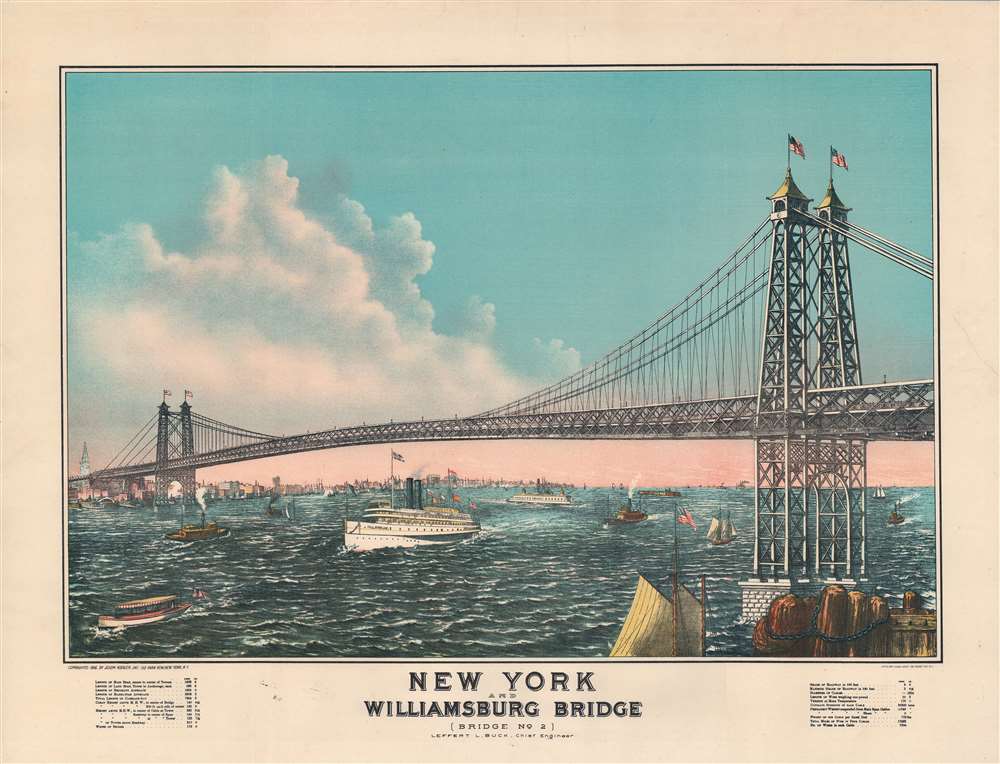Digital Image: 1916 Koehler Chromolithograph View of the Williamsburg Bridge, New York City
WilliamsburgBridge-koehler-1916_d
Title
1916 (dated) 20 x 26 in (50.8 x 66.04 cm)
Description
FOR THE ORIGINAL ANTIQUE MAP, WITH HISTORICAL ANALYSIS, CLICK HERE.
Digital Map Information
Geographicus maintains an archive of high-resolution rare map scans. We scan our maps at 300 DPI or higher, with newer images being 600 DPI, (either TIFF or JPEG, depending on when the scan was done) which is most cases in suitable for enlargement and printing.
Delivery
Once you purchase our digital scan service, you will receive a download link via email - usually within seconds. Digital orders are delivered as ZIP files, an industry standard file compression protocol that any computer should be able to unpack. Some of our files are very large, and can take some time to download. Most files are saved into your computer's 'Downloads' folder. All delivery is electronic. No physical product is shipped.
Credit and Scope of Use
You can use your digial image any way you want! Our digital images are unrestricted by copyright and can be used, modified, and published freely. The textual description that accompanies the original antique map is not included in the sale of digital images and remains protected by copyright. That said, we put significant care and effort into scanning and editing these maps, and we’d appreciate a credit when possible. Should you wish to credit us, please use the following credit line:
Courtesy of Geographicus Rare Antique Maps (https://www.geographicus.com).
How Large Can I Print?
In general, at 300 DPI, you should at least be able to double the size of the actual image, more so with our 600 DPI images. So, if the original was 10 x 12 inches, you can print at 20 x 24 inches, without quality loss. If your display requirements can accommodate some loss in image quality, you can make it even larger. That being said, no quality of scan will allow you to blow up at 10 x 12 inch map to wall size without significant quality loss. For more information, it is best consult a printer or reprographics specialist.
Refunds
If the high resolution image you ordered is unavailable, we will fully refund your purchase. Otherwise, digital images scans are a service, not a tangible product, and cannot be returned or refunded once the download link is used.
Cartographer S
Joseph Koehler (1842 - May 22, 1933) was a New York based lithographer, printer, and stationer active in the late 19th and early 20th century. Koehler was born in near Reims, France, the son of a prominent medical doctor, also Joseph Koehler, once the personal physician to Napoleon Bonaparte. In 1846, when he was just 4, Koehler immigrated to the United States with his family, settling in New York City. He is tentatively credited with the invention of the 'greeting card' in 1867, when he was 21. Following on the success of his greeting card business, Koehler built an extensive postcard and calling card business, which today represents the bulk of his surviving corpus. Most of his pieces were printed at factories in Germany, France, and England. Later, in the 1890s, he established his own steam press operation at 150 Park Row - then a printing hub. Koehler, while a pioneer in half-tone printing, is better known for retaining the more labor-intensive chromolithographic process well into early 20th century due to its superior graphic effect. Most scholarship suggests he retired around 1914, but we have seen later work attributed to his firm dating to 1916, so this may be erroneous. In addition to his printing work, Koehler also imported tobacco and smoking paraphernalia. He also inherited the formula for a medicinal cure-all balm developed by his father, which he marketed as 'Arabian Balsam'. More by this mapmaker...
Charles Hart (March 10, 1824 - October 9, 1914) was a pioneering British-American lithographer active in New York from the mid-19th century to the early 20th century. Hart was born in London and immigrated to New York as a child. He briefly worked in a glassware shop before, in 1939, becoming an lithographer's apprentice under George Endicott (June 14, 1802 - 1848). Five years later in 1844 is graduated from his apprenticeship, joined the fully-paid staff of Endicott Lithography. He must have been greatly appreciated within the firm, as in 1850, his salary of 20 USD a week was among the highest in the trade. When the Endicott offices burnt to the ground in 1859, Hart moved to the firm of Robertson, Siebert and Shearman. When this partnership collapsed in 1861, Hart partnered with James Alpheus Sherman (1816 - 1890), creating the firm 'Shearman and Hart.' Shearman left the firm to peruse a legal career shortly thereafter and from this point forward, Hart published independently. Hart retired from active lithography in 1911, when his sons, Francis and Horace Hart, took over. He died in 1914. Learn More...

